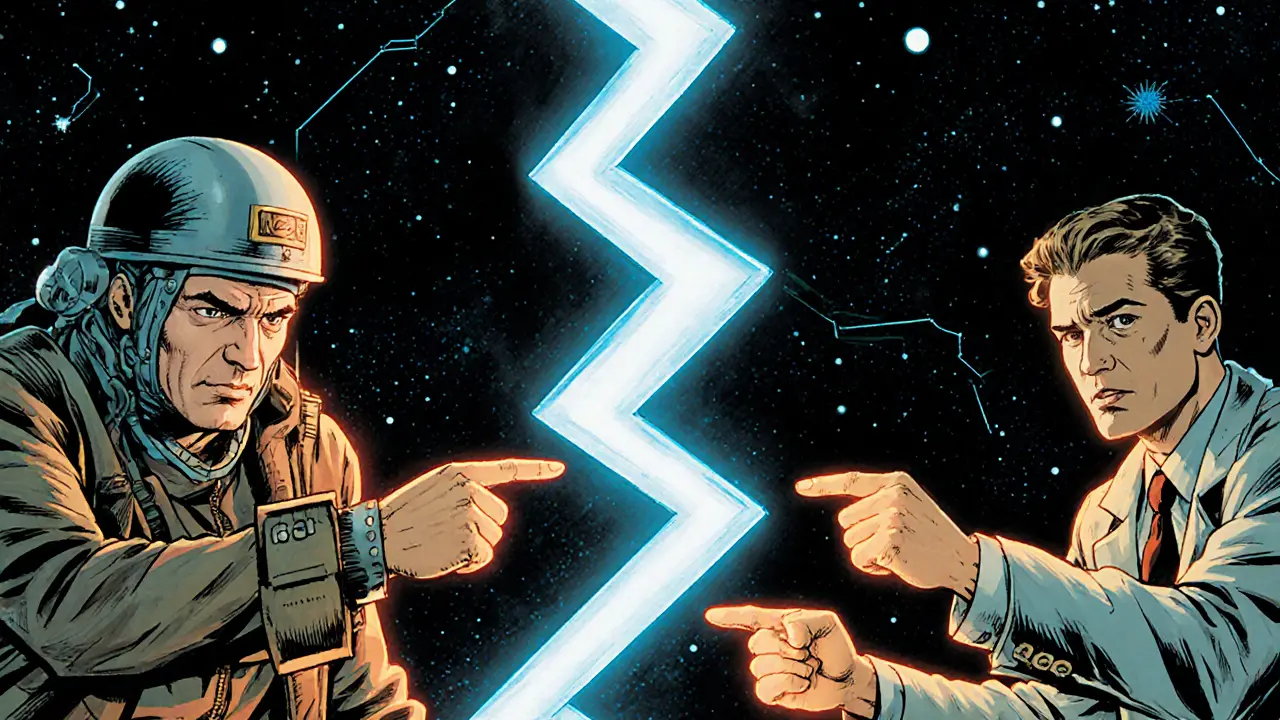
Quick Summary
- A blockchain fork is a split in a blockchain’s transaction history that creates two separate chains.
- Forks happen to fix bugs, add features, scale the network, or resolve community disagreements.
- Soft forks are backward‑compatible; hard forks create permanently incompatible chains.
- Major examples include Bitcoin Cash, Ethereum Classic, and the Ethereum Merge.
- Fork announcements often trigger 15‑30% price swings and can fragment or strengthen a community.
Understanding why forks occur and how they work is key for anyone dealing with cryptocurrencies-whether you’re a trader, developer, or just curious about the tech behind the hype.
What Is a Blockchain Fork?
Blockchain fork is a divergence in a blockchain’s transaction ledger that results in two distinct, co‑existing histories from a certain block height onward. The split happens when the network’s protocol rules are altered, causing some nodes to follow one set of rules and others to follow another.
Why Do Forks Happen?
Forks are the blockchain’s way of upgrading without a central authority. The most common drivers are:
- Scalability pressures: When transaction throughput caps out, developers may increase block size or change consensus timing.
- Security fixes: Critical bugs or vulnerabilities (like the 2016 DAO hack) demand rapid protocol changes.
- Feature additions: New functionality-e.g., EIP‑1559’s fee model-requires rule changes.
- Governance disagreements: Community members sometimes clash over the network’s future direction, prompting a split.
- Regulatory or compliance needs: Adjustments to meet emerging legal frameworks can also trigger forks.
Each driver follows the same technical path: someone proposes a change, the community reviews it, and if consensus forms, the change is scheduled for a specific block height.
Types of Forks
Forks fall into two technical categories based on backward compatibility.
| Aspect | Soft Fork | Hard Fork |
|---|---|---|
| Compatibility | Backward‑compatible; old nodes still recognize new blocks | Incompatible; old nodes reject new blocks and vice versa |
| Chain split | Usually no permanent split; one chain continues | Creates two separate chains with shared history up to the fork point |
| Typical use‑cases | Minor rule tightening, new opcodes, transaction format changes | Major protocol overhauls, block size changes, consensus mechanism swaps |
| Community impact | Usually smooth; minimal user disruption | Can split communities, create new coins, cause market volatility |

Four‑Stage Fork Implementation Process
The roadmap from idea to live split typically follows four phases.
- Identification: Developers, users, or miners spot a problem or opportunity-e.g., Bitcoin’s block‑size debate.
- Proposal development: The change is codified as a formal improvement proposal (BIP, EIP, etc.) or a raw code pull request.
- Review and testing: The community runs testnets, audits security, and gauges support. Public debates on forums and voting mechanisms often shape the final decision.
- Execution: Once a majority agrees, the fork is scheduled at a predetermined block height or timestamp. Nodes that have upgraded follow the new rules; those that haven’t fall behind or switch to the other chain.
This structured approach reduces chaos, but real‑world forks still generate excitement-and anxiety.
Real‑World Examples That Shaped the Industry
Seeing forks in action helps demystify the concept.
- Bitcoin Cash (BCH) emerged in August 2017 as a hard fork from Bitcoin. The community wanted an 8MB block size to boost transaction capacity, while Bitcoin miners favored the 1MB limit. The split created a new cryptocurrency with its own hashpower and market cap.
- Ethereum Classic (ETC) resulted from the 2016 DAO fork. After a $50million hack, the Ethereum community voted to roll back the exploit (creating ETH), but a minority insisted on “code is law,” keeping the original chain as ETC.
- EIP‑1559 (London Hard Fork) in August 2021 introduced a base‑fee mechanism that burned a portion of transaction fees, making ETH mildly deflationary. This soft‑to‑hard hybrid upgrade altered economics without spawning a new coin.
- The Merge (September2022) was arguably the most complex hard fork ever. Ethereum shifted from Proof‑of‑Work to Proof‑of‑Stake, changing the consensus algorithm while preserving the same ETH token.
- Litecoin is a classic code‑base fork of Bitcoin that introduced faster block times (2.5minutes) and a different hashing algorithm (Scrypt) to diversify mining.
Market Impact and Risks
Fork announcements are financial events. Historical data shows price swings of 15‑30% for the affected coin in the days surrounding a fork. Successful hard forks can create multi‑billion‑dollar market caps (Bitcoin Cash topped $20B shortly after launch). Conversely, contentious splits often dilute network effects, leading to reduced hashpower and lower adoption.
Investors should watch three signals:
- Community sentiment: Is the split backed by a majority of miners, developers, and users?
- Technical readiness: Have wallets, exchanges, and infrastructure upgraded to support both chains?
- Economic incentives: Does the new chain offer clear benefits-lower fees, faster confirmation, or novel features?

Future of Forks: Governance, Modularity, and Interoperability
As blockchain ecosystems mature, the need for disruptive hard forks is waning. Modern projects embed formal governance tools (on‑chain voting, DAO structures) that let token holders decide upgrades without splintering the network. Layer‑2 solutions like rollups allow experimental changes on a secondary chain, preserving the main chain’s stability.
Modular blockchain designs-where consensus, execution, and data availability are separate layers-make it possible to upgrade one component without triggering a full‑chain fork. Cross‑chain bridges and interoperability protocols (e.g., Polkadot, Cosmos) further reduce friction between divergent forks, enabling assets to move freely regardless of which chain they reside on.
Regulators are still catching up. Some jurisdictions treat forked tokens as new securities, while others view them as extensions of the original asset. Staying informed about local legal guidance is essential for anyone planning to launch or trade a forked cryptocurrency.
Practical Tips When a Fork Is Announced
- Backup your private keys before any upgrade; a compromised wallet can’t be recovered.
- Check exchange support: Confirm that the platforms you use will list both chains and how they handle deposits/withdrawals.
- Update your node software early if you run a full node; delay can cause you to fall behind the network.
- Monitor community channels (Discord, Reddit, GitHub) for real‑time status updates and potential security warnings.
- Consider diversification: If a fork splits the market, you might allocate a small portion of your holdings to the new chain to capture upside while limiting exposure.
Frequently Asked Questions
What exactly happens to my coins during a hard fork?
If you held the original coin on the fork date, you automatically receive an equal amount of the new coin on the new chain-provided you control the private keys. Exchanges may handle the distribution for you, but it’s safest to move to a non‑custodial wallet and claim manually.
Can a soft fork cause a split in the blockchain?
Normally no. A soft fork is backward‑compatible, so nodes that don’t upgrade can still validate new blocks. However, if a large portion of miners refuse to upgrade, the network can end up in a temporary disagreement that may resolve into a split.
How do developers propose a fork?
Most major chains use formal improvement proposals-Bitcoin Improvement Proposals (BIPs) or Ethereum Improvement Proposals (EIPs). The proposal includes technical specifications, rationale, and a schedule. Community members then discuss, test, and vote on the change.
Do forks affect the security of a blockchain?
A hard fork can temporarily lower security if the new chain inherits less hash power or fewer validators. Over time, the network stabilizes as miners or stakers allocate resources based on economic incentives.
Are forks still relevant in 2025?
Yes, but they are evolving. Governance tools, modular architectures, and layer‑2 scaling are making forks less disruptive, yet they remain the primary method for major protocol upgrades.






There are 17 Comments
Kimberly Kempken
If you think blockchain forks are some kind of divine revelation, you’re living in a delusional utopia. The reality is that most forks are just power grabs dressed up as community upgrades. Hard forks especially tend to fragment hashpower and leave ordinary users scrambling. The so‑called “innovation” often just creates a new token to siphon off speculative hype. In short, forks are more about ego than engineering.
Eva Lee
While the sensationalist narrative thrives on drama, the technical substrate involves protocol versioning, consensus rule re‑negotiation, and state transition function amendments. Your omission of stake‑based finality mechanisms is a glaring gap, especially post‑Merge. Moreover, the interplay between L1 governance modules and L2 rollups can mitigate disruptive hard forks, a nuance you completely ignored.
Carthach Ó Maonaigh
Yo, forks are basically the blockchain’s version of a family feud – everyone shouting over who gets the inheritance. People act like a split is some heroic act, but most of the time it’s just a bunch of devs and miners fighting for a bigger slice of the pie. The hype around new coins is a gold‑mine for pump‑and‑dump schemers. If you’re not careful, you’ll end up holding a token that’s worth less than the gas you paid to get it.
Brooklyn O'Neill
That’s a fair point, but let’s remember that community governance can actually smooth out those feuds when it works. By fostering open discussion and transparent voting, we can channel the energy into constructive upgrades rather than chaotic splits. Encouraging collaboration early on reduces the risk of creating a worthless fork.
Greer Pitts
Hey folks, just wanted to say that if you see a fork announced, the first thing to do is back up your seed phrase. It’s easy to forget, but losing access to your wallet means losing everything, forked or not. Also, keep an eye on whether your favorite exchange supports both chains – that can save you a lot of headaches later.
Lurline Wiese
OMG, did anyone else feel the adrenaline rush when the Merge hit? It was like watching a blockbuster climax, except the whole world’s crypto portfolio was on the line! The drama of PoW giving way to PoS was pure theater, and the community’s reaction was a perfect blend of panic and euphoria. Still, the after‑effects were worth every second of suspense.
Jenise Williams-Green
Let’s get real: promoting forks as progress is a moral hazard. When you glorify a split, you implicitly endorse a system where developers can fork away from users’ interests for personal gain. The ethical responsibility lies with the community to demand transparency and accountability, not with hype‑machines that profit from confusion.
Laurie Kathiari
Honestly, the moral high ground you claim is just a veneer. The same players shouting about accountability are the ones who profit when a token’s price spikes after a fork. It’s a classic case of self‑serving virtue signaling-talk the talk, but when the cash rolls in, they’re all in.
Katherine Sparks
Dear community, I’d like to emphasize the importance of thorough preparation when a fork is announced. Ensure your private keys are safely stored, verify that wallet software supports the upcoming change, and keep a close watch on official communication channels. These steps can dramatically reduce the risk of accidental loss or exposure.
Ciaran Byrne
Absolutely, backing up keys and staying informed are critical. In addition, consider testing the new client on a testnet before upgrading your main node. This helps catch compatibility issues early and protects your operations.
Cynthia Rice
Forks reflect the inherent decentralization of blockchain.
Jim Griffiths
When you read about blockchain forks, it’s easy to get lost in the technical jargon and miss the broader implications that affect everyday users. First, a fork changes the consensus rules, which means that nodes must decide which version of the protocol to follow. This decision isn’t just a software update; it represents a fork in the community’s trust. Second, the economic impact can be profound. Investors often see price volatility ranging from 15 to 30 percent as markets react to uncertainty. Third, security considerations shift. A hard fork can temporarily reduce the total hashpower protecting the network, making it more vulnerable to attacks. Fourth, forks create new assets that may dilute the original token’s value, especially if the new chain doesn’t attract sufficient adoption. Fifth, regulatory landscapes may treat the new token as a separate security, which can complicate compliance for businesses. Sixth, wallets and exchanges need to update their infrastructure, and any lag can lock users out of their funds. Seventh, developers must maintain codebases for both chains if they want to stay relevant, which can strain resources. Eighth, community governance dynamics evolve; a split often signals deeper ideological disagreements. Ninth, communication is key-clear announcements help prevent panic and misinformation. Tenth, users should back up private keys and consider moving funds to non‑custodial wallets before a fork occurs. Eleventh, following the fork’s progress on GitHub and official forums gives insight into the technical health of the upgrade. Twelfth, testnet participation allows users to experiment without risking real assets. Thirteenth, assessing the long‑term roadmap of both chains can guide investment decisions. Fourteenth, watch for post‑fork incentives, such as airdrops, which can affect market behavior. Fifteenth, remember that not every fork is beneficial; some are merely attempts to capitalize on hype. By keeping these points in mind, you can navigate forks with a clearer strategy and avoid common pitfalls.
Matt Nguyen
It is evident that the mainstream narrative surrounding blockchain forks is deliberately engineered to obfuscate the true power structures at play. Those who champion decentralization often ignore the covert alliances between major exchanges, mining pools, and venture capital that dictate fork outcomes. The public discourse is a smokescreen, intended to keep the average participant compliant while the elite reap disproportionate rewards.
Shaian Rawlins
Hey everyone, I wanted to share a balanced perspective on forks. While they can be disruptive, they also serve as vital mechanisms for evolution within blockchain ecosystems. By allowing communities to experiment with new features, forks can lead to meaningful improvements that benefit all participants. It’s crucial, however, to approach each proposal with a clear understanding of its technical merits and potential socioeconomic impact. Engaging in open dialogue, reviewing the code, and participating in testnets are all constructive ways to contribute. Ultimately, the goal should be to foster resilience and innovation without sacrificing security or user trust.
Tyrone Tubero
While I see the idealism in the previous comment, let’s not forget that dramatic upgrades often come at a cost. The dramatic flair surrounding hard forks can mask underlying performance bottlenecks that still need to be addressed. It’s a reminder that spectacle should not replace substance.
Natalie Rawley
Okay, listen up-if you think you can just sit on the sidelines and watch forks happen, you’re missing the point. The market rewards the bold who jump in early, study the proposals, and position themselves accordingly. Don’t be that clueless bystander.
Scott McReynolds
Friends, let’s approach this with optimism and a touch of philosophical curiosity. Forks, at their core, represent a collective decision-making process-a digital reflection of how societies evolve. By embracing these moments as learning opportunities, we can deepen our understanding of decentralized governance. It’s not merely about profit; it’s about participating in a transformative experiment. Together, we can nurture a resilient ecosystem that balances innovation with responsibility.
Write a comment
Your email address will not be published. Required fields are marked *